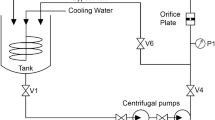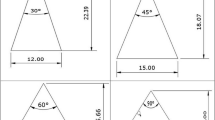Abstract
New experiments have been carried out on the generic case of the flow through orifice plates. The aim has been to validate empirical correlations used for the prediction of cavitation. The new accurate experimental data base shows that earlier proposed empirical correlations work well for the prediction of cavitation, e.g., Tullis (1993), Miller (2009), and Nilsson (2011). Using the present data together with earlier data from Tullis (1993), it has been shown that, at the onset of cavitation, the ratio between the downstream and the upstream pressure over the orifice plate is a simple linear function of the orifice plate diameter ratio, β = d/D. This has been shown to hold independent of flowrate, downstream pressure, orifice diameter (for 0.4 < β < 0.8, which corresponds to a pressure loss coefficient 1 < ξ < 100) and boundary conditions (e.g., upstream pipe bends), at moderate temperatures and as long as the pressure drop is large compared to the saturation pressure. A novel and simple rule-of-thumb for when the cavitation becomes a problem (i.e., in between critical cavitation and incipient damage) has been demonstrated to be when the ratio between the downstream and the upstream pressure over the orifice plate equals the orifice plate diameter ratio.
Similar content being viewed by others
Change history
05 February 2022
A Correction to this paper has been published: https://doi.org/10.1007/s42757-022-0132-z
References
ANSYS. 2018. ANSYS Fluent User's Guide (Release 19.0).
Bagade, V. S. 2019. A review of multi-hole orifice plate. Int J Res Appl Sci Eng Tech, 7: 3197–3208.
Brennen, C. E. 1995. Cavitation and Bubble Dynamics. Oxford University Press.
British Standards Institution (BSI). 2003. BS EN ISO 5167-2. Measurement of fluid flow by means of pressure differential devices inserted in circular-cross section conduits running full - Part 2: Orifice plates.
Ferrarese, G., Messa, G. V., Rossi, M. M., Malavasi, S. 2015. New method for predicting the incipient cavitation index by means of single-phase computational fluid dynamics model. Adv Mech Eng, 7, https://doi.org/10.1177/1687814015575974.
Hallvig, R. 2017. Forsmark 3 - Kravställt flöde och strypningar i system 322, F-0064631.
He, C., Lai, J., Yan, J., Xi, Z., Yuan, S., Sun, L. 2016. Research on vibration issue due to pipe orifice cavitation. Nucl Power Eng, 37: 65–69.
Miller, D. S. 2009. Internal Flow Systems, 2nd edn.
Nilsson, J. 2011. Forsmark 3 - EFFE Engineering System 322 Motiv till systemlösning och strypningsutformning i wet well. WEFFE 09-0765 rev 1, FT-2011-2267 rev 0.
Rudolf, P., Kubina, D., Kozák, J., Hudec, M., Pochylý, F. 2017. Dynamics of the cavitating flow downstream of the orifice plate. AIP Conf Proc, 1889: 020033.
Sylvio, R., Bistafa, S. R., Lauchle, G. C., Reethof, G. 1989. Noise generated by cavitation in orifice plates. J Fluids Eng, 111: 278–289.
Takahashi, K., Matsuda, H., Miyamoto, H. 2001. Cavitation characteristics of restriction orifices (experiment for shock pressure distribution by cavitation on restriction orifices and occurrence of cavitation at multiperforated orifices due to interference of butterfly valve). In: Proceedings of the CAV 2001: Fourth International Symposium on Cavitation.
Testuda, P., Moussou, P., Hirschberg, A., Aurégan, Y. 2007. Noise generated by cavitating single-hole and multi-hole orifices in a water pipe. J Fluid Struct, 23: 163–189.
Tullis, J. P. 1993. Cavitation guide for control valves (NUREG/CR-6031). Nuclear Regulatory Commission, Washington, DC (United States).
Vehar, F., Lipejek, A., Pavlin, R., Skerlavaj, A., Jancar, B., Cernec, M. 2013. Numerical and experimental design of multi-stage orifice FWRO-004. In: Proceedings of the 22nd International Conference on Nuclear Energy for New Europe.
Wang, Y., Zhuang, S., Liu, H., Zhao, Z., Dular, M., Wang, J. 2017. Image post-processed approaches for cavitating flow in orifice plate. J Mech Sci Tech, 31: 3305–3315.
Zhang, Y., Li, Y., Ji, J. 2011. Simulation of hydrodynamic cavitation equipment with orifice plates. Chem React Eng Tech, 27: 219–223. (in Chinese)
Acknowledgements
Hans Lindqvist and Richard Hallvig at Forsmarks Kraftgrupp AB are highly acknowledged for the internal financial support and fruitful discussions. M.Sc. Joschka Schulz, TU-Berlin, is highly acknowledged for subsequently deriving the theoretical part.
Author information
Authors and Affiliations
Corresponding author
Rights and permissions
About this article
Cite this article
Angele, K. Prediction of cavitation in orifice plates—A novel and simple rule-of-thumb. Exp. Comput. Multiph. Flow 3, 68–76 (2021). https://doi.org/10.1007/s42757-020-0059-1
Received:
Revised:
Accepted:
Published:
Issue Date:
DOI: https://doi.org/10.1007/s42757-020-0059-1




